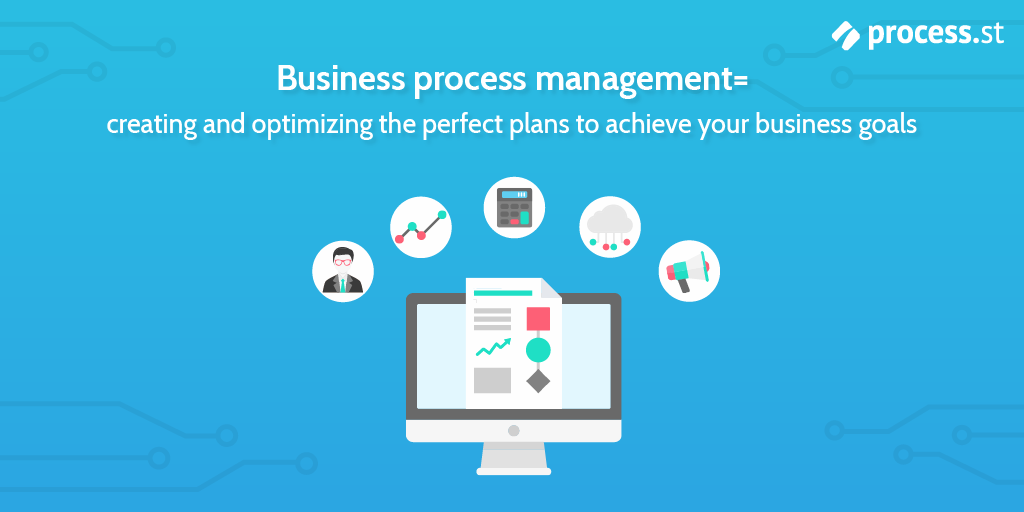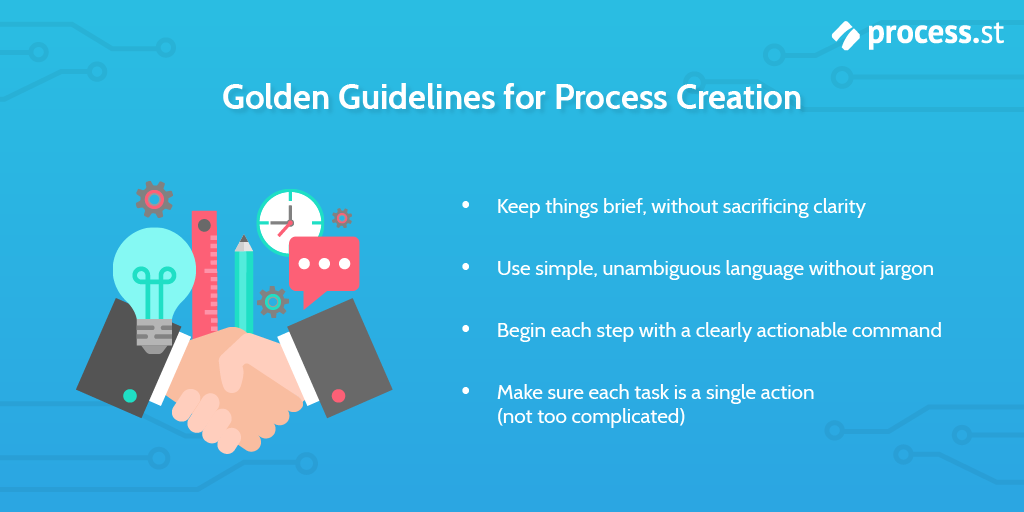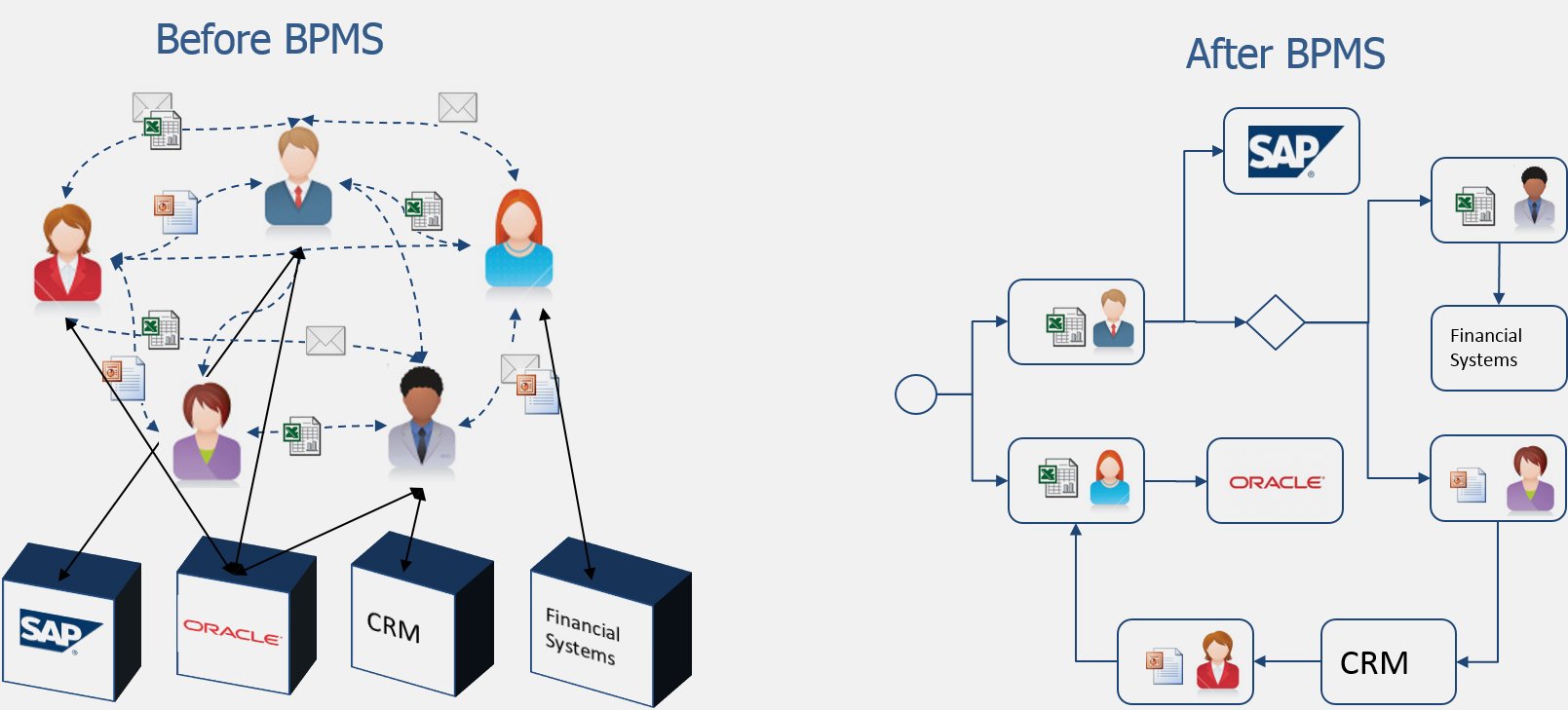
This is a guest post from Mary Hampton is a content marketer, sharing experience on writing, education, and self-development in her publications. In her free time, she enjoys writing fiction as well as reading it.
Businesses are constantly under pressure to stay ahead.
This makes anything that can provide increased performance an important edge – especially if it doesn’t have too many drawbacks.
In a market where even the smallest optimization can go a long way, business process management just might be what you’re looking for.
Today’s Process Street article takes a look at pretty much every reason why you might want to implement a BPM suite for your business.
What is business process management suite (BPMS)?
To put it simply, a business process management suite is a system in which a company creates, analyzes, and updates all of its processes.
What’s a process? Well, it’s basically any kind of set of instructions that can be followed to get work done. Processes are reliable, and a business process management suite allows businesses to focus on principles of continuous improvement to improve success rate and reduce inefficiency.
Typically, different departments within a company are responsible for following and maintaining their own processes. Each department is responsible for its own processes, and usually a single department within an organization will have dozens of unique processes, if not more.
Even if you don’t think you’re using processes in your business, you are. Everything has a process – even the worst, least optimized processes for doing work is still a process. That’s what makes a business process management suite so unanimously appealing.
The idea is to take a step back and look at all of the different processes from as many perspectives as possible. Not only on an organizational level but on the level of individual processes.
Only by analyzing the current state of the processes being used can areas of improvement be identified in order to achieve a more efficient and effective organization.

BPM suites can be defined by their purpose: to create, analyze, and optimize each and every process involved in achieving your business goals.
Far more than a simple software tool, business process management is an ongoing process of continuous improvement. BPM never stops, because you can never really think of a process as “perfectly optimized”. Optimization should be an ideal that is constantly pushed for, but in most cases never settled upon.
That’s the purpose of a BPMS: to challenge current operations, and maintain a continuous initiative of process improvement within an organization.

What makes company executives pay attention to BPM suites?
BPM suites, in general, can bring a lot of benefits to your company. There’s no wonder that interest in BPMS is surging and so many executives are asking the question: “What is business process management?”
The multitude of benefits that implementing a BPM suite can provide have been clearly shown, and here we’re going to take a good look at each of them.
1. Decentralized process
In a centralized management system, power is limited to one person or a group of people, such as a CEO or board of directors.
When this power is decentralized, lower levels of management are more involved in the decision making process and overall process quality improves as a result.
After all, it makes sense to include the people who are actually using the processes in decisions about these processes.
This is important because the information a middle manager has can be important to a top manager making a decision. With centralized decisions, the expertise from other levels may not be taken into account.
2. Discover inefficient workflows
When committing to a BPM suite, the first thing to do is to discover what is going on in the company. In doing this, you might realize that there is repetitive data in the company’s system. This can be difficult for a company as it can clog up systems.
For instance, if a member of the company needs to look something up and finds several entries pertaining to what they need, it can get confusing.
With a BPM suite – particularly an iBPM suite – a company can reconcile these records. Rather than having to delete them manually, these entries can be joined into a single entry, clearing up the system.
3. Eliminate repetitive tasks
As noted, a big part of BPM suites is improving and optimizing systems. One way to do this is to use the analysis to cut out unnecessary duplicate systems. A BPM suite will help to sync employees up.
This is because a BPMS help to analyze a business’ operations and notice details such as expenses for multiple systems. From there, you can look at ways to improve and optimize these processes by removing systems that are repetitive and consolidate departments and teams onto the same IT systems.
Not only will this save resources, but it will also make company-wide policies and communication much easier.
4. Increase transparency between departments
Gathering information with a BPM suite also helps you to improve transparency between departments. Think of an essay writing service, for instance. If a paper that a writing service’s author writes doesn’t match editorial guidelines that the writer didn’t know about, it’s going to be hard for that writer and editor come up with something that measures up.
Now, think about that same company with a BPM suite. It could analyze the situation and implement guidelines clear to both departments. This would allow them to function more cohesively and create better products.
5. ERP systems just aren’t working
Maybe you already have an ERP (enterprise resource planning) system in place and it just isn’t working.
Unfortunately, these systems aren’t always the right fit for a company and they can be difficult to operate at times.
In these cases, a BPM suite might be the right alternative. A BPMS allows you to easily customize processes and adapt to situations as they happen.

They are meant to offer ease of use. With that, they try to provide the most efficient path to higher effectiveness and productivity.
BMP systems may also be more in-depth than ERP systems, allowing them to give more accurate results.
6. You’re a fast-growing document repository
A business that has a large document repository might have trouble keeping everything straight – especially during periods of quick growth. There are a few reasons that a BPM suite can help with this.
First, it can help store and organize documents while still allowing them to be accessed for editing. These documents are usually stored on the cloud or a central system too, allowing employees across departments to access what they need.
Simultaneously, a business can also add authentication steps to protect documents that aren’t meant for every member of the company to see or use.
7. Fragmentation across departments kills effectiveness
We mentioned earlier that if intentions across departments can kill productivity. This doesn’t just go for ideas and guidelines, though.
It can also include barriers and fragmentation due to IT systems. This is unfortunate as fragmentation of any kind can reduce the effectiveness of employees and departments.
Once again, this is why a central system can save the day. When there is one system that unites all departments, they are more likely to work well together and pool resources or ideas.
A BPMS can offer that universal system to business.
8. Current software is difficult for employees
Technology is constantly evolving and certain systems can be hard for employees to adapt to. While a company can take the time to train employees on complex systems, it can oftentimes be more intuitive to use a system that’s easier to understand from the beginning.
Most BPM suites are rather easy to adapt to. This is because they are made to be that way. These are systems meant to help businesses make their operations run more smoothly. As part of this, they are made to be easily integrated and, as such, are designed to have a minimal learning curve for new users.
9. The Company Needs Are Complex
At certain points in a business’ life cycle, they may not need a complex system. Most companies, though, reach a point when their needs become more complex.
The need for a quality BPM suite grows as factors of the business gets more complicated, such as when more employees are brought on, more locations are opened, or clientele expands.
A BPMS can help to order and process information within the company. Consistent and adaptable organization and processing like this is essential for any growing business.
10. Employees waste a lot of time searching
If an employee has to spend more than 30% of their time searching for information, this is greatly cutting down on their time they have to work on forwarding progress. In these cases, it’s important to take measures to make sure that this searching is made simpler.
A BPM suite helps this as it makes information more accessible to anyone looking for it. This also reckons back to reconciling repetitive entries of data.
With a simple search, employees will be able to find the information they need all in one place rather than looking through multiple entries.
11. Employees are confused about structure

The final problem we will look at is employee confusion. In a job, employees are tasked with certain responsibilities. If they don’t know how to take care of those responsibilities, though, they’re going to be difficult if not impossible to handle. This can a notable problem when employees are given new, unfamiliar tasks and responsibilities.
The base of information that a BPM offers can help employees to find information on their tasks and how to do them in a shorter amount of time.
This can reduce the learning curve of employees and cut down on time spent confused as to what to do.
12. Lack of mobility
The problem with many office systems is that even if they work great in the office, they may not be mobile. This can make it difficult when employees need to work outside of the office or remote workers are hired.
BPM suites are made to help handle this problem. Since they are online, it is possible to access necessary information from anywhere.
Many also have mobile applications that allow individuals to access information from a device such as a cell phone when they are away from a computer.
This can be especially helpful if an employee needs to answer a client’s, customer’s, or even fellow employee’s questions on the go.
13. Employees are caught up in documentation
In many offices, employees spend a lot of time working on spreadsheets and sending emails back and forth. This, once again, comes back to storing information and being able to find it quickly.
If a query needs to be answered, it can take up a lot of unnecessary time trying to email back and forth between departments or management levels.
Having that information readily available and less troublesome to find means that this time conversing back and forth can be used to increase productivity and innovation. With a BPM software like Process Street, you can achieve a truly paperless office.
The less time an employee has to spend struggling, the more time and energy they have to put into their responsibilities.
14. Finding information is too complicated
Some decisions in business need a lot of time and thought. Other times, these decisions call for a quick reaction. No matter which situation that someone within a company is in, they need to have access to information readily.
It can be much more difficult to make these decisions if the information needed for them is hard to find and confusing.
If you focus on improving your business processes, you will be able to streamline this information and make it available to the parties who need it when they need it.
15. Your team is managing too many projects
If for your current system, any of your departments have to keep multiple projects going, it’s draining a lot of energy from other potential projects.
This, again, comes down to reducing productivity. A BPM suite doesn’t take quite as much effort to keep going which saves wastage of labor and time within a company’s system.
Rather than being bogged down with running a system, they can focus on improving systems and taking care of other undertakings the company needs.
16. You only run in a niche
It’s important for a company to find its place in the market. Unfortunately, if they get stuck in a niche or only have a system that takes care of a niche of their corporation, growth can be incredibly difficult. Instead, you need a system that can encompass everything your corporation has to handle. Using a BPM suite is a great way to make sure that the system that helps you run your company is just as flexible as your company’s growth.
17. Integration costs were higher than expected
Integrating business with technology is critical in the modern era. However, it can also come at quite the expense.
With proper planning, some of these costs can be avoided. A BPMS help company owners and managers to analyze the risks and benefits of decisions before they are made.
In addition, they can help you to measure performance in certain areas – such as IT integration – and help improve and optimize the plan.
Automation can also help cut down on costs such as manual labor when it is implemented correctly.
A BPMS is an important step to success
All in all, there are plenty of reasons that companies of any size can benefit from the use of a business process management system. It can help you evaluate where your company is at now, in detail, and determine the best way to move forward that will be in the best interest of the company.
Using Process Street for BPM
Process Street is your best bet for quickly and easily implementing a BPM suite in your business.
It’s a comprehensive BPM software and workflow automation tool that allows you to streamline your tasks and save time and money with process automation.
You can run checklists to nail down standard operating procedures, collect data with rich form fields, and integrate over 1,000 of your favorite apps.
There’s so much you can do with Process Street. Take a look at this webinar for a whole bunch of ideas for how to use Process Street for BPM:
Free BPM ebook
Once you’re done with that, why not check out just some of these other Process Street resources for business process management:
- The Ultimate Guide to Business Process Automation
- The Complete Guide to Business Process Management
- Ultimate Guide to Small Business Automation with Zapier
And of course, don’t forget to sign up for a free Process Street account today!
Did we miss any reasons why you might want to implement a BPM suite? If you can think of anything, or want to add anything else, let us know in the comments below.







 Workflows
Workflows Forms
Forms Data Sets
Data Sets Pages
Pages Process AI
Process AI Automations
Automations Analytics
Analytics Apps
Apps Integrations
Integrations
 Property management
Property management
 Customer management
Customer management
 Human resources
Human resources
 Information technology
Information technology



Oliver Peterson
Oliver Peterson is a content writer for Process Street with an interest in systems and processes, attempting to use them as tools for taking apart problems and gaining insight into building robust, lasting solutions.